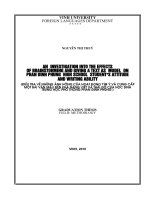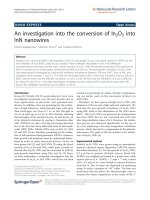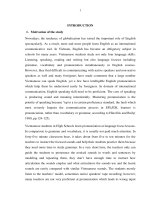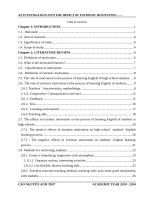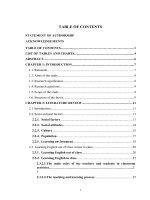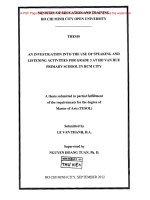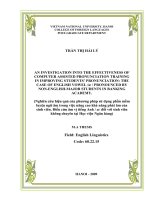an investigation into the efficiency of esl lab application to enhance communicative skill for ethnic students
Bạn đang xem bản rút gọn của tài liệu. Xem và tải ngay bản đầy đủ của tài liệu tại đây (453.73 KB, 28 trang )
AN INVESTIGATION INTO THE EFFICIENCY OF ESL-LAB APPLICATION TO
ENHANCE COMMUNICATIVE SKILL FOR ETHNIC STUDENTS
MÔN: TI NG ANH
S
GIÁO D C VÀ ÀO T O NGH AN
TR
NG THPT QU PHONG
AN INVESTIGATION INTO THE EFFICIENCY OF ESL-LAB APPLICATION TO
ENHANCE COMMUNICATIVE SKILL FOR ETHNIC STUDENTS
MÔN: TI NG ANH
Tên tác gi : V n Thái Hoàng
T : V n – Anh
N m th c hi n
S
tài: 2021
i n tho i liên h : 0888 618 497
TABLE OF CONTENT
CHAPTER 1: INTRODUCTION ............................................................................... 2
1.1 Rationale .............................................................................................................. 2
1.2 Aims of the study ................................................................................................. 3
1.3 Research methods ............................................................................................... 3
1.4 Scope of the study ................................................................................................ 3
CHAPTER 2: LITERATURE REVIEW AND THEORETICAL
BACKGROUND........................................................................................................... 5
2.1 Literature review................................................................................................. 5
2.2 Theoretical background ..................................................................................... 6
2.2.1 Listening skill ................................................................................................ 6
2.2.2 Communicative skills .................................................................................... 8
2.2.3 Esl-lab application ........................................................................................ 9
CHAPTER 3: RESEARCH METHODOLOGY .................................................... 11
3.1 Participants ........................................................................................................ 11
3.2 Questionnaires ................................................................................................... 11
3.3 Interview ............................................................................................................ 12
3.4 Data collection ................................................................................................... 12
3.5 Implementation of esl lab ................................................................................. 12
CHAPTER 4: FINDINGS AND DISCUSSION ...................................................... 13
4.1 The first cycle of using Esl-lab ......................................................................... 13
4.2 The procedure of input acquisition and practice ........................................... 14
4.3 The procedure of output practice .................................................................... 16
4.4 The third cycle of oral performance................................................................ 18
4.5 What are students’ attitudes toward the Esl-lab? ......................................... 22
CHAPTER 5: CONCLUSION .................................................................................. 23
5.1 Recapitulation.................................................................................................... 23
5.2 Implication ......................................................................................................... 24
REFERENCES ........................................................................................................... 25
1
CHAPTER 1: INTRODUCTION
1.1 Rationale
In the globalization era, cooperation among countries has promoted the
development of the economy, culture, and society. The largest language which has been
spreading around the globe is English. It helps people connect, have better
understandings of the world, its challenges through information booming that satisfies
advantageous access to travel, education, and cultures.
In Vietnam, English is a compulsory subject in the national curriculum from grade
3 to grade 12. It helps students improve English communication and contribute to
developing other skills for work and study more effectively. Besides, this subject
provides students with an essential international communication tool to update new
knowledge about cutting-edge science and technology, cultural discovery. Learning
English raises their insights into people of other countries and makes them aware of
global citizens.
The English subject's primary focus aims to develop the fluency and proficiency
of language skills for students in listening, speaking, reading, writing, and linguistic
knowledge. Although more and more students excel in learning English, the number of
students having difficulties in listening and speaking skills has increased steadily. This
evidence can be observed at most high schools in Vietnam that they cannot perform
enough verbal communication in English in the classroom and outside the classroom.
This problem is caused by many factors, including the geographical location,
environment for practicing English, learning styles, acquisition abilities, and others.
The study "An investigation into the efficiency of ESL-lab application to enhance
communicative skills for ethnic students" is selected to solve the challenges in listening
and speaking students face. The application of Esl-lab intends to get students involved
in essential listening, vocabulary, and grammar tasks because these play a vital role in
attracting students' attention to the voice of native speakers, encouraging them to
identify the vocabulary in context, and practicing post-listening task verbally. Another
interesting point of Esl-lab is that learners can interact with the system whenever they
aspire to have their devices, such as mobile phones, computers connected to the
internet. Finally, the learning process combined with technology integration meets the
needs of the fourth industrial revolution facilitating students with the skills to explore
the online system, practice free English listening exercises in bulk, discover global
cultures, accumulating more vocabulary, and communicating better.
2
1.2 Aims of the study
The purposes of the study are aimed at:
- investigating students’ attitudes toward listening and speaking skills when
using Esl-lab.
- exploring how effectively Esl-lab helps students enhance their communicative
skills.
- devising learning and teaching methods to support students with the
improvement of communication.
1.3 Research methods
This paper employs action research with three cycles to investigate the
effectiveness of applying Esl-lab. The first cycle deals with introducing Esl-lab to
students regarding the content website and entering listening practice. In this process,
they open the system and do the listening exercises. Turning to the second cycle, the
survey will be given to students with the aims of eliciting the problems they face while
using Esl-lab, navigating their attitudes toward listening and speaking tasks they have
done. All the collected data will focus on orientating appropriate methods for students
to improve the following listening results. The methods relate to listening tactics and
different strategies provided for students to apply.
Besides, the students' results are saved after each task in detail to satisfy the
assessment's needs. After that, the author checks the students' understanding by a set of
questions relating to the listening content. Students are asked to produce
communicative performances in the third cycle through different activities, including
interviews and presentations. The author also provides feedback and recommendations
for students to improve their performance.
Furthermore, students are encouraged to share their voices regarding what they
learned, how they learned, and what they wish to further English skills via the
interviews. The recorded speech will be evidence for the efforts and expectations they
make. Finally, the research covers the efficiency of Esl-lab to promote students'
progress in learning English.
1.4 Scope of the study
In this study, there are 90 participants who are the 11th graders at Que Phong high
school. Que Phong is a mountainous district located in the west of Nghe An province.
It is 173 kilometers away from Vinh city and shares a border with Laos. Que Phong has
many people from the Thai, Mong, and Kho Mu ethnic groups. Most students at this
school come from remote communes of Que Phong districts and had disadvantaged
backgrounds.
3
Due to the influence of impoverished life and other factors, they have many
difficulties in learning English. Besides learning English at school, they have very little
guidance to improve their English listening and speaking skills for themselves. Despite
having internet connections, very few students explore English materials online for
their study.
According to the new general education program requirements, the integration of
information technology is the focus of quality enhancement of teaching and learning.
In the English subject, listening and speaking are essential skills that require learners to
practice frequently. Recognizing the students' challenges, the Esl-lab is used to help
students practice language skills better without paying any fees for it. The selected
listening and productive tasks of the Esl-lab are at the elementary level, which meets
fulfilment’s learning progress. This website is a motivation for them to improve their
English and have autonomy in self-study.
4
CHAPTER 2: LITERATURE REVIEW AND THEORETICAL
BACKGROUND
2.1 Literature review
There have been a number of considerable papers regarding the enhancement of
oral skill in various ways.
The paper on communication among undergraduates conducted by a group of
scholars in Malaysia (2011) showed that verbal communication, written
communication, and social communication encourage students to develop discussion
and presentations in class and engage in real-world career success.
Omer and Aslihan (2009) focused on factors affecting students’ performance on
listening skill. The author employed different research methods investigating students’
progress, including questionnaire, in-class listening tasks, out-of-class context and their
voices on listening. The research results revealed that their learning achievement was
strongly supported by their father’s education and computer time increase. The next
effect related to the number of books they read in a month. The assisting tools, such as
radio, newspaper, and players, significantly contributed to motivating students’
performance tasks in class.
Dilek (2019) researched an effective method to develop watching/listening
comprehension skills in Turkish teaching to enhance word and sentence in a discourse.
This approach activates students’ thinking on language elements, semantics, sociocultural knowledge and the utterance conveyed by the speaker. The final results stated
that students were able to use language and strategies constructively and effectively.
Neri and Santi (2019) put forward research on improving listening skill by using
some listening applications. After performing the three stages, including pre-test,
treatments, and post-test, the students’ ability to listen improved. Furthermore, their
interest in learning was motivated by modern media, especially smartphones.
Erwin (2014) did a study on improving speaking skill through communicative
activities. According to Shumin in Richards and Renandya (2002), speaking
effectiveness consists of grammatical competence, sociolinguistic competence,
discourse competence, and strategic competence. The applied activities were
discussion, role play, simulation, information gap, brainstorming, storytelling,
interview, story completion, reporting, playing cards, picture narrating, picture
describing, finding the difference to increase students’ speaking skill. The contents of
those are related to human real-life and connected with four components of
communicative competence.
5
2.2 Theoretical background
2.2.1 Listening skill
Listening is one of four Basic English skills: reading, writing, speaking and
listening (Spratt et al., 2005:30). Like reading, Listening is a creative skill (Rivers,
1981:160), as it involves responding to language rather than producing it. Listening
involves making sense of the meaningful (having meaning) sounds of language. We do
this through context and our knowledge of the language and the world.
Anyone who uses language well has a number of different abilities. He may read
a book, write letters, speak on the telephone, listen to the radio. In the most general
way, we can identify four primary skills: listening and understanding, speaking, reading
and understanding and writing (Harmer 1983:16). Speaking and writing are skills and
involve some kinds of productive skills that the language users apply. Listening and
reading are receptive skills in that the language learner is receiving written or spoken
language.
Adrian Doff (1998:199) mentioned some types of listening. Active Listening,
Empathic Listening, Critical Listening, Casual Listening, Focused Listening
Active listening is a communication technique that requires listeners to respond
to what the speaker had said in his own words. This model includes listening with
comprehension and with a purpose.
Empathic listening is also called active or reflective Listening. It is a way of
listening and responding to another person that improves mutual understanding and
trust. It is an essential skill for third parties, and disputants enable the listener to receive
an accurate response. The response is an integral part of the listening process and can
be critical to the success of a negotiation/meditation
Critical listening reflects the ability to listen critically is essential in a democracy.
There is practically no place he can go where critical Listening is unimportant, whether
on the job, in the community, at service clubs, in the place of worship or the family.
Politicians, the media, salesmen, advocates of policies and procedures and our own
financial, emotional, intellectual, physical and spiritual do require us to place a
premium on critical Listening and the thinking that accompanies it.
Casual listening is many times we listen to someone or something without any
particular purpose. At such times, we often do not listen to them with much
concentration unless we hear something which interests us. This type of Listening is
often found in a social context when we interact with others.
Focused listening or ‘Intensive Listening’ for information or for transacting
business. The listener is attentive and concentrates on what the speaker is saying.
6
The listener as Critic is an evaluation that shows the speaker’s authentic image
and compares it with the ideas he might attain. The precautions while listening to the
verbal messages.
1) Avoid making fast assumptions.
2) Paying particular attention to the intended meanings when the speaker uses
words describing strong feelings.
3) Be alert to the ways by language manipulation.
4) Hear with the speaker’s ear interact with you.
5) Be alert to the impact of non-verbal messages.
Howett and Dakin (1974) considered that listening is the ability to explore and
recognize the content others are saying. This involves detecting speakers’ accents or
pronunciation, grammar and vocabulary and grasping the messages.
Wolgin and Coakley (1982) regarded listening as a process of receiving, attending
to, and assigning meaning to aural stimuli.
Pearson (1983) stated, “Listening involves the simultaneous organization and
combination of skills in phonology, semantics, and knowledge of the test structure, all
of which seem to be controlled by the cognitive process.
Hirsh (1986) gave another definition that listening is an aspect of skills, including
neurological response and interpretation of sounds to understand and produce meaning
by reacting, selecting ideas, remembering, attending, analysing, and including previous
experience.
Bentley and Bacon (1996) stated that listening is an integral part of the second
language learning process during which the listener constructs meaning from oral input.
According to Brown (2001), listening is not solely a process of unidirectional
receiving audible symbols. He supposed that listening comprehension is the
psychomotor process of receiving sound waves through the ear and transmitting nerve
impulses to the brain.
Listening comprehension is one of the most challenging skills to learn in a
foreign language (Longman, 1987:156). Listening involves a sender (a person, radio,
and television), a message, and a receiver (the listener). Listeners often must process
messages as they come, if they are still processing what they have just heard, without
backtracking or looking ahead. Besides, listeners must cope with the sender's choice of
7
vocabulary, structure, and delivery rate. The listening process's complexity is magnified
in second language contexts, where the receiver also has incomplete control of the
language.
2.2.2 Communicative skills
Speaking is the natural state of language, as all human beings are born to speak
their native languages. This verbal communication involves not only producing
meaningful utterances but also receiving others' oral productions. Speaking is thus
regarded as a critical skill in learning a second or foreign language by most language
learners, and their success in learning a language is measured in terms of their
accomplishment in oral communication (Nunan, 1998; Nunan, 2001).
Even though acquiring oral skills is considered to be necessary, speaking did not
have primacy in language learning and teaching in the past. Historically, learning a
structural language, rote memorization of sentence patterns and vocabulary and using
literary language were considered superior to practising the spoken language. These
pedagogical activities were supported by the Grammar Translation Method (Richards
& Rodgers, 2001). However, in the mid-nineteenth century, the importance of teaching
grammar for grammar's sake decreased due to the existence of opportunities for
achieving conversational skills in learning a foreign language. Europeans were
travelling more and sought to build business and personal connections through learning
and to use the languages of Europe. Some language specialists, especially Frenchman
F. Gouin (1831-1896), developed new language teaching methods, which impacted
language pedagogy. Gouin supported the idea that language learning requires using
spoken language related to a sequence of natural physical actions: walking across a
room, opening a door, and so on (Richards & Rodgers, 2001). Other innovations in
language teaching encouraged ways of language learning using a speech-based
approach to language instruction. These innovations supported by a Direct Method of
language teaching dominated language teaching in the 20th century.
Speaking plays a vital role in communication. Ur (1996), Bailey and Savage
(1994: vii) claim that "for many people, speaking is seen as the central skill because of
the desire to communicate with others, often face-to-face and in real-time". In Ur's
opinion, speaking is intuitively considered as the most crucial skill of the four ones.
According to Haws and Thomas (1994), it is all too easy to make the mistaken
assumption that just any kind of speaking activities can develop students" competence
in an ESL spoken English course. If the course's focus is on conversational skills, this
will not ensure that learners will develop the ability to use language for informative
purposes, which is the aspect of spoken English that students most often have difficulty
8
with. These skills must be introduced as a component in their own right and explicitly
taught.
Also, the authors state that one of the related problems that teaching speaking
encounters is motivation. To encourage language learners to speak without hesitation,
the teacher should raise a willingness and a need to talk in each learner by providing
them with familiar topics or situations they feel they need or are reasonable to talk
about. The resultant lack of interest and motivation can be attributed to the
purposelessness of the language they are being asked to produce.
In speaking, learners try out new vocabulary and develop a working knowledge
of language form and structure once visually prompt and culturally familiar information
is provided. In oral learning, facing clues like intonation and gesture enhances
understanding (Dawes, 2008: 44).
Knowing a certain amount of grammar and vocabulary does not help learners of
a foreign language master it; they also need to employ the forms and the new vocabulary
items in real-life situations. The teacher's role has been shifted from building repertoire
to teach and test items to building students' skills in using these items (Jensen, Santrock
& Franklin: 2007:32).
Oral skills should be taught before writing skills. Time for the oral rehearsal of
the sentence is crucial (Hiatt & Rooke, 2002: 31). National and international research
suggests that a student's voice is of great significance when it involves the active
participation for decision making, the opportunity for learning exploration and
construction, learning personalization, leadership distribution and authentic real-life
situations (Department of Education and Early Childhood Development,2009).
In speaking tests, it is necessary to get students to recognize that there is a
difference between knowing about a language and the skill to use it (Bygate, 2003). By
this, learners of the language treat what they learnt and processed sounds and words to
compose oral outcomes for specific purposes, suiting the context in which it occurs.
Such a process includes the participants or the speaking partners, the experience, the
physical environment and the purposes for speaking (Baker & Wenstrup, 2003).
Speaking is integrated with listening skill. Speakers should have their audience and
receive feedback to understand the meanings of the speakers' messages (Jones,1996).
2.2.3 Esl-lab application
The Esl-lab website was established by Randall, who graduated with a master's
degree in TESL. Since his profession's inception, he had excellent chances to travel
globally to share technological applications in education and absorb new knowledge of
cultures and neighbors' identity. His research interests include video technology,
CALL, language teaching, teacher training, and learner autonomy. Apart from ESL, he
9
also creates more websites fulfilling English learning, such as Daily ESL, EZSlang, and
Train Your Accent.
To use the online recording files on the Esl-lab.com, the computer needs installing
some assisting software and the Internet connection. At this forum, the listening
practice tasks range from the three levels: Easy, Intermediate, and Difficult. Therefore,
it is efficient for learners to practice and improve their English by selecting proper
exercises levels.
In case learners do not identify what level of English they are achieving currently;
the easy level will be a perfect choice. Each audio file lasts from 1 to 3 minutes, which
focuses on the listening types and their equivalent levels. For easy level listening
exercises, the conversation length is short and separated. The recorded sentences are
simple, and speaking speed is slow, so listeners can get familiar with the content and
avoid distraction.
Turning to the intermediate and challenging levels, the conversations' length will
be longer; the recorded sentences are more complicated, the speaking speed is faster
with the mixture of people's voices of different countries and territories, which fosters
the more challenging levels of listening tasks. Therefore, the initial selection of levelbased listening tasks helps learners establish a stable listening basis and prevent
boredom.
After choosing the level of listening tasks, they can see many alternative topics
about life, such as education, family, sport, travelling. It is convenient to practice with
favorite topics and boost listening skill.
Like other listening practice websites, Esl-lab integrates more pieces of
conversation for learners to follow and reference the scripts under the position of audio
files. That it becomes more unique compared to other websites is the system of attached
exercises which are diversely designed in the form of multiple-choice questions and
gap-filling.
Learners can both listen and complete the questions below. Then, the system will
check the answers, making it possible for them to identify their scores. The exercises
will be more difficult in conjunction with the higher level. They do not have to worry
much if the results do not meet their expectations.
A bonus for Esl-lab is that each listening always provides some essential idioms,
explanation, vocabulary, and examples below the conversation. This helps learners
review and accumulate more lexical resources to explore the meaning and apply it in
the real world like the way native speakers do.
10
CHAPTER 3: RESEARCH METHODOLOGY
3.1 Participants
The 11th graders are the main participants of this study. Their English level
ranges from elementary to pre-intermediate. Because of facing underprivileged
backgrounds, their learning is also a barrier for knowledge acquisition and practice.
This practice results from the unique feature of a mountainous high school located in
Que Phong district, an impoverished area in the West of Nghe An. Students have
undergone the lack of learning facilities in remote communes, which is far away from
the town, about more than 30 kilometres. Most of their parents work as farmers, so they
do not have enough time to manage their children's learning. The other reasons are low
academic achievement, harsh road conditions to travel, and living far from school. Most
ethnic students have very few opportunities to take extra lessons after school, so free
learning resources enrich learning styles.
The focus of extending communication throughout the English curriculum at
schools stems from the new general education program's requirement and the direction
from the National languages project 2020. Many schools in big cities of Vietnam have
implemented various models to diversify the English-speaking environment for
students and spur the students' communication with foreigners, which results in
exceptional outcomes of students' progress in English. Another factor contributing a
step forward in oral skill is the internet-based learning resource. Like students in big
cities, ethnic students here have access to the internet via different devices. The practice
of the English language is becoming more and more convenient.
3.2 Questionnaires
To collect the data for this study, one perception questionnaire is used to measure
students’ attitudes toward listening tasks they completed on the Esl-lab. The questions
are designed in close-ended and open-ended. For close-ended questions, the
participants find it easy to fill a tick from number 1 to 5 equivalent to their opinions (1
Strongly Disagree, 2 Slightly Disagree, 3 Neutral, 4 Slightly Agree, 5 Strongly Agree).
The open-ended questions aim at asking students about their difficulties in learning
business English.
Brown (2001) states that “Questionnaires are certain written instruments that
show responses to a set of questions or sentences, either by writing down their answers
or sorting out from existing answers.
Markey & Gass (2005) claims that using questionnaires in language researches a
valuable instrument that lets researchers investigate and gather information on
participants‟ beliefs and motivations in such a short time with comparable information
elicited from several correspondents. For the outstanding advantage of questionnaires
11
mentioned above, the author decided to use questionnaires in this paper to investigate
students‟ attitudes and motivations towards communication acquisition.
3.3 Interview
The researcher observed the speaking lesson done by students through different
tasks of communication. After the class observation, the author interviewed some
students to reaffirm the collected results from students’ practice.
3.4 Data collection
Data analysis is a process of inspecting, transforming, and modelling data to
highlight useful information, suggesting conclusions, and support decision-making.
One of the aims of giving an evaluation was to know how far the students mastered
English speaking skills by applying the Esl-lab.
The questionnaire was designed through a google form, which makes participants
available to provide feedback. Finally, the google system automatically synthesizes the
answer and launches the data through graphs.
3.5 Implementation of esl lab
First and foremost, the website esl-lab.com was provided for students with the
introduction of the whole page and some steps to access communication interaction.
The technical guidance was essential for them to get familiar with the tasks. Then, they
were assigned a listening task on the system to complete. There was a sequence of
exercises for checking listening comprehension and speaking. Next, the teacher
investigated the final score they got on listening.
The marks on the correct answers they accomplished encourages their curiosity
to discover new topics. This is the very first time they have had access to the forum in
which English language is used, so the guidance needs to foster their learning
motivation. In addition, the listening part is crucial to the development of post listening
skill.
Turning to the speaking, students have the opportunity to make some utterances
on the topic’s content. The main focus is they demonstrate the answers to the questions
set by the system and some requirements made by the teacher. The procedure assessing
the speaking performance bases on the rubric and the input they had.
12
CHAPTER 4: FINDINGS AND DISCUSSION
4.1 The first cycle of using Esl-lab
THE CHART SHOWS THE RESULTS OF FIRST
TEST ON ESL-LAB
Correct answers
Number of students
100%
80%
60%
10
22
18
24
13
3
4
3
2
1
2
3
4
5
0
6
40%
20%
5
0%
1
Correct answers
5
4
3
2
1
0
Number of students
10
22
18
24
13 3
Percentage (%)
11.1 24
20
26.7 14 3.3
Figure 1: The results on the first test
The bar chart illustrates the proportion of students’ outcomes on the first listening
test of Esl-lab. In general, 11 percent of students achieved the highest correct answers
with five questions. The second-ranking of 4 correct answers belonged to 24 percent of
students. The third place for three correct answers reflected 20 percent of students. The
rate increased considerably to more than 6.7 percent in the number of students getting
two right answers. The lowest scores were one correct answer, and zero had 14 percent
and 3.3 percent, respectively.
The levels of English among students are different because they lack input
sources. Firstly, they lack lexical resources, making them impossible to listen to a
speech or a conversation. Secondly, they are weak at pronunciation. Despite
recognizing some words’ letters, they have difficulty identifying the word meaning,
intonation, and speaking speech. The next barrier is the shortage of sentence structure
to explore meaning in the listening task. Furthermore, the teacher instructed students to
use the Esl-lab system by guiding them to open the listening tasks, choosing their
favourite topic and completing the task. Students were asked to learn vocabulary and
explore meaning before entering task completion.
13
4.2 The procedure of input acquisition and practice
The author chooses some topics concerning the ones they have learned in the
textbook. There are six topics selected: college life, family activities, happy new year,
happy birthday, reading books, and social media websites. These topics provide
knowledge of cultures, activities, and celebrations in a foreign context, so students have
to identify the details of listening tasks and talk about the related topics by referring to
a real-life context.
Before entering the main task, students’ knowledge is activated by listing some
details relating to the big topics. The teacher focuses on highlighting special idioms
appearing in the listening task. Each idiom has a demonstrated example.
College life
- “a walking encyclopedia” = someone who seems to know everything
“My roommate would do well on a trivia game show. He’s a walking
encyclopedia.”
- “have the right stuff” = have the needed skills to succeed
“Susan has the right stuff to get into any school she chooses.”
Family activities
- “keep an eye on” = watch carefully
- “Be sure to keep an eye on the kids so they don’t get to close to river.”
- “homesick” = sad at being away from home or things that are familiar
“My roommate is really homesick and can’t think about anything else but his
mom’s cooking.”
Happy New year
- “turn over a new leaf” = change personal habits
“I’ve decided to turn over a new leaf; I’m going to exercise three times a week
and not play so many video games.”
- “ring in the new year” = celebrate the new year
“We’re going to ring in the new year at my sister’s house next week.”
Happy Birthday
- “turn” = become a year older
“Our youngest daughter is going to turn 16 this week, and we’re all excited to
celebrate her special day.”
14
- “mooch off of someone” = expect someone to pay your expenses
“Hey, now that you’ve turned 25, don’t you think it’s time to stop mooching off
of mom and dad?”
Reading book
- “bookworm” = someone who loves to read
“My daughter is a bookworm, and she reads at least two hours a day.”
- “be an open book” = be a person who hides nothing about your life
“Please ask me anything. I’m an open book.”
Social media websites
- “keep in touch” = stay in contact or communications with someone
“Using popular social media Web sites is one way to keep in touch with family
and friends.”
- “reach someone” = be able to contact or talk with someone
“If you want to talk, you can reach me by phone, by email, through FaceBook.”
After teaching some vocabulary, the teacher instructs some strategies for
students to complete multiple-choice questions:
- Read through the questions
- Underline the keywords
- Listen for keywords and identify information
- Give the correct answers.
Most of the listening exercises are in the form of multiple-choice questions, so
students find it easy to complete. However, the proper answers need exact information
as located in the recording. The students are forced to listen more than twice because
they have to keep listening on track and identify the content. Furthermore, the
transcription is designed in the form of gap-filling for them to complete.
15
While practicing the listening tasks, students’ results on listening are different
from the post-test results.
THE RESULTS OF INPUT PRACTICE
100%
90%
80%
70%
60%
50%
40%
30%
20%
10%
0%
16.70%
26.7%
28.9%
22.2%
5.5%
15
24
26
20
5
5
4
3
2
1
2
3
4
1
correct answers
correct answers
Number of students
Percentage
5
Number of students
5
4
3
2
1
15
24
26
20
5
16.70%
26.7%
28.9%
22.2%
5.5%
Figure 2: Results of practice
The bar chart shows the students’ input results on listening conducted on the Esllab website. This time students made better progress in the performance with a surge of
up to 16.7 percent. The second-ranking score accounted for 26.7 percent. The third
proportion was at 28.9 percent. The rate of students getting the lowest score for two
correct answers plummeted to 22.2 percent and 5.5 percent, respectively.
Under the teacher's guidance, students get better results because they pay more
attention to vocabulary acquisition, listen for specific details, and study the
transcription carefully. Weak students are encouraged to learn more with the repetition
of knowledge and language. They not only listen to the recording, but they also have
some insight into the content. To check their understanding, the teacher set a list of
questions relating to the listening content. Notably, the higher results than the previous
ones reinforce the learning pace and awareness to accumulate new knowledge.
4.3 The procedure of output practice
It is inevitable that listening need the integration of communication for the whole
listening content. The focus is based on the post-listening tasks and the context of
16
listening content. The students are required to perform oral speaking by making
dialogues and giving a brief presentation.
College life
Interview another student about the topics below and report your findings to the
class:
What university do you want to enter?
What undergraduate program do you plan to study?
What are the requirements of the entrance exam?
How is the classroom environment?
Will you stay in the dormitory or rent a hostel?
Will you do part-time employment
What club activities will you join?
Family activities
Talk about your family with a partner using some of clues:
How many people are in your family?
What do your parents do?
What kinds of activities does your family do together?
What is one thing you like or dislike about your family?
Happy new year
Happy New Year
Make a short talk about new year celebration
What things did you do with family and friends to ring in the new year?
What special foods did you eat?
Do people in your country have any special traditions they do on that day?
Happy Birthday
Share a story about one of your favourite birthdays.
How did you celebrate the day, and what made it special?
Did you eat any special foods? What presents did you receive?
Are there any unique birthday traditions and customs in your family or culture?
17
Reading
Make a presentation about reading
What are the benefits of reading?
What types of material are best for learners of different ages to understand the
content they are reading?
How can students learn to read without the help of a dictionary?
Social networking site
Make a dialogue on social network
Which social networking sites do you visit and use?
How often do you use them?
Who do you contact or talk with on these sites?
What are both the positive and negative points with such sites?
4.4 The third cycle of oral performance
The information to such a question is explored on the internet and via discussion
among students. The teacher supplies them with some websites and instructions to
discover knowledge. When they perform the speaking, a rubric is applied to score their
performance.
Evaluation and assessment processes are conducted before, during, and after
learning. Heaton (1990), Underhill (2000), and Weir (1993) suggest that teachers assess
and evaluate a learner’s communication ability via re-telling stories, interviewing,
asking questions, giving a point, and doing a role play. Other techniques include using
pictures for description, comparison, sequencing, and pictures with speech bubbles and
maps. Wongsothorn (1995) presents three speaking types: reporting, description, restorytelling, giving an opinion, analysing, and interviewing with discussion or debate.
Commonly, educators assess students’ speaking abilities depending on the
techniques used by the teacher.
18
Figure 3: Speaking evaluation sheet
Name: ________________________________
Criteria
Excellent
(5)
Date: __________________
Good Satisfactory
(4)
(3)
Below
Unsatisfactory
average
(1)
(2)
A. Fluency
Suitable speed,
pauses and
discourses strategies
how positively
students contribute
to the conversation
B. Communicative
ability
The length of
utterances
Flexibility to
speakers of different
level, complexity of
responses.
C. Accuracy/
grammar
How accurate and
appropriate students’
grammar is, verbs,
sentence structure,
individual grammar
points, functional
phrases.
D. Vocabulary
If student uses a
wide variety of
words and phrases,
or uses new
19
vocabulary, learned
and related to the
topic. Word choice,
idioms, and phrasal
verbs, appropriate in
each context.
E. Pronunciation
Effort made to use
correct intonation,
stress, individual
sounds.
F. content
Topic elaboration,
organization,
coherence and
cohesion, suitable
connectors.
The above table shows the criteria for assessing learners’ performance.
Performance criteria play a crucial role in assessing procedures. They need to connect
with the lesson objectives and target language application through tasks designed to
assess. At the same time, each item of the criteria list collaboratively engages in
marking learners’ performance. As assessing a group’s performance, the criteria
include accuracy, fluency, content, and others.
Fluency is the bridge between recognition and comprehension. It is highly
correlated with comprehension and inclined to make sense when fluent. Besides, it is a
reflection of decoding, strategies, comprehension, and self-monitoring. In speaking,
intonation, phrasing, inflection and expression are taken into account.
The communicative ability is assessed through the conversation's length that
learners can interact with based on their levels.
Accuracy or grammar point is also an essential means of assessing the
performance of the target language. It reflects students’ abilities to use the target
language through provided input. Specific grammatical points are focused on, such as
words, phrases, vocabulary, and sentence structure.
20
Vocabulary assessment reveals how well students make use of word sources for
communication. Significantly, the topic-related vocabulary is carefully checked in
specific topics along with word choice, idioms, and phrasal verbs, appropriate in each
context.
The content shows how well students organize the ideas in communication. It also
involves cohesion, coherence, and topic elaboration.
28-30: excellent
11-23: satisfactory
26-27: very good
< 10: unsatisfactory
24 - 25: good
Feature 4: The results on speaking performance
Results of speaking performance
40.0
26.7
17.8
15.6
36
24
16
VERY GOOD
GOOD
SATISFACTORY
Number of students
14
UNSATISFACTORY
percentage
The results of the post-listening task look more characteristic. 17.8 percent of
students achieved excellent results. Good results account for 40 percent. The
satisfactory level is at 26.7 percent, and the lowest rate belonging to the unsatisfactory
group is 15.6 percent.
The preparation for speaking performance is well-accomplished thanks to the
assistance of the internet. They tried their best to establish dialogue and presentation.
Although students show good knowledge of the listening content and their facts, they
had difficulty pronouncing ending sounds and intonation. In contrast, the unsatisfactory
group needs more effort to consolidate the knowledge and practice.
21
4.5 What are students’ attitudes toward the Esl-lab?
strongly Slightly
Slightly Strongly
Neutral
disagree Disagree
Agree Agree
I enjoy the opportunities of
communicative exchanges through
various forms of tasks.
4%
4%
8%
32%
52%
I usually feel nervous during the
performance of oral tasks in the
classroom.
32%
20%
18%
20%
10%
Task performance in the class is fun to
4%
me
4%
22%
26%
44%
I tremble when I am called on to
perform an oral task in front of other
students
14.3%
20.4%
25%
18%
22.4%
I don’t worry about making mistakes
when I perform oral tasks in the
classroom
8%
6%
20%
32%
34%
Even though I am well prepared for
the task performance session, I feel
nervous about it
12.2%
16.3%
16%
29%
26.5%
Tasks help me engage in spontaneous
interactions
4%
10%
14%
32%
40%
Task performance in the classroom
will prepare me to cope with
communicative challenges in the real
world.
2.1%
6.3%
21%
25%
45.8%
Tasks help me make actual use of
expressions and grammar patterns I
have learned
4%
4%
20%
44%
28%
Figure 5: Students’ attitudes toward Esl-lab for communication
22
The bar chart illustrates the percentage of students giving feedback on the postlistening tasks. Most students are into communication through various tasks with 52
percent, the most significant figure. The second most considerable percentage of
students considering task performance helps deal with communicative challenges is
45.8. Next, 40 percent of students strongly agree that tasks help them participate in
spontaneous interaction, and 44 percent consider tasks fun to them.
The proportions of students finding communicative exchanges are fun, and tasks
help make use of expression and grammar stay the same level at 4 percent. When asked
about how they feel while doing oral, 32 percent of students did not feel nervous while
doing tasks. In contrast, 10 percent felt nervous in performance. Besides, 24.2 percent
trembled at being called on to perform oral skills, as 14.3 percent did not agree with it.
In terms of mistakes, 34 percent of students are eager to perform the task without being
afraid of making mistakes, whereas 20 percent of students share the balance of mistake
commitment. Twenty-nine percent of students slightly agree that they felt anxious about
the performance despite preparing well. On the contrary, 16.3 percent slightly disagree
with performance anxiety. Forty-four percent of students slightly agree that grammar
and expression are essential, converse to 28.
CHAPTER 5: CONCLUSION
5.1 Recapitulation
The study is conducted to enhance communication for students by using Esl-lab.
The selected topics for students relate to culture, society, education, and celebrations.
Besides getting input, they can exchange ideas in real life through group works or pair
work in discussion and role-play. In cognitive load, each task in listening and discussion
and business skill contains speaking activities for students to develop their ideas.
Cognitive load relates to many activities that students need to do and the availability of
prior knowledge in the task (Ellis, 1998:227). The speaking tasks fulfill the criteria of
well-achieved learning targets and objectives of the whole unit. In the listening and
discussion, the speaking task is designed with guiding questions, making it easy for
students to activate and further develop their background knowledge on different topics.
The post-listening tasks upgrade the interaction in which students have a more
environment to perform oral skills in different contexts.
Generally, the speaking task contains language and situations appropriate to realworld context through the three parts, listening, discussion, and business skill. Nunan
(1989:59) claims that the task classroom activities should reflect the “real world” as
closely as possible. Because the language is a vehicle for communication, methods and
materials should concentrate on the message, not the medium. Graves (2000:154) also
suggests that suitable activities in the materials should be as authentic as possible to see
23
